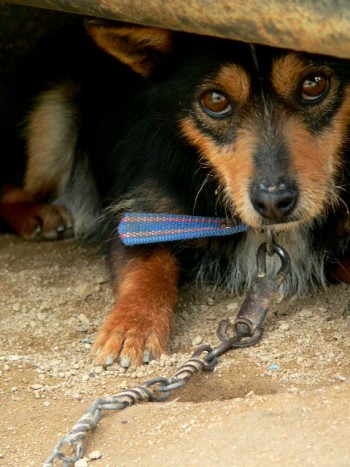You see a dog on your way to work. His collar has been on so long that he has a permanent mark around his neck. His dish is full of spicy-looking leftovers. The chain he’s tied to gives him about 90 cm of territory to jump around in. Perhaps he no longer jumps around, he only sleeps. There’s no evidence he’s ever been walked- or at least not in a long, long time. You’re not sure why his owners keep him. What can you do?
Everything depends on the situation and how comfortable you feel with the dog, the property, and the owner (see CAUTION, below) but here are a few ideas on how to improve a chained dog’s life:
- Visit and give her attention.
Dogs are social creatures that live in packs. That they bond with humans so readily is one of the reasons that makes them special to us. Visiting regularly will give them the attention they so desperately crave and give them some socialization skills they most certainly lack. Bring treats for an icebreaker. You will be repaid 100-fold in tail wags and kisses. - Befriend the owner.
Getting to know the owner of the dog might be tricky if you only speak a little Korean. Still, it’s good conversation practice, and well worth it. Try a few of these phrases. Tell them how much you love dogs in general, or how pretty this one is, but don’t preach about the way you think a dog should live. Being friendly will do more good and allow you to try more of the ideas below. - Give good food.
While kimchi and rice taste good to us, they probably don’t meet dogs’ carnivorous nutritional requirements. Bring good quality dog kibble regularly, or leave a bag for the owner to feed. A new food dish to replace the fry pan might be nice, too. - Provide fresh water.
Dogs need a constant supply of water, especially in summer. Fill your Nalgene with good, fresh water and (re)fill the dog’s water dish. You may also need to buy a water dish, the heavy kind that is less likely to be spilled, and get rid of that pot with the algae in it. - Give some bedding.
Many dogs live in old dog houses that don’t protect them from the elements. Fresh hay makes nice insulation. Failing that, a flannel shirt, fleece blanket or some old piece of wool clothing could also provide comfort. The latter choices do get wet and freeze, so be sure to return to change and wash them after rain or snow. - Buy a doghouse.
Even a wrecked old house is better than no house, and no house is what some dogs get. Rain or shine, wind or snow, they live outside without a roof. If a dog doesn’t have a house, or if it’s too run down to do much good, bring one as a present. If you feel awkward, maybe tell a story like “My friend’s grandmother in (name a village) doesn’t need this anymore, so I’m bringing it to you...” The small size black-and-red rubber houses cost about 30,000won. - Bring a toy.
As we know, dogs are intelligent animals. Spending all day alone makes them bored and stressed. Leaving a safe toy appropriate for the dog’s size - a tennis ball, a Kong, or even a knotted piece of towel - can give them something to do for a while. - Buy a new collar.
Often dogs that are kept chained away from people aren’t monitored. They’re collars are often old and fit improperly. Bringing a new collar might help stop the chafing around his neck. It’ll also make him look better and maybe inspire the owner to take better care of him. Here's a beautiful letter shared by an ARK member in the forums (see posts #11-14) who gave an anonymous gift of a collar to the owner of a local chained dog. - Get your groom on.
Neglected dogs don’t get the care they need, period. Once you’ve gotten to know the dog and he trusts you, bring a brush and give him a brush down. Cleaning his ears with antibacterial doggy ear wash can help prevent infections. Brushing his teeth will prevent painful gum diseases, especially important if he has an inappropriate diet. Clipping his toenails will prevent painful ingrown nails. A clean dog has more chance of being allowed inside. Since the neglected dog is probably not used to these things, proceed with CAUTION. - Give parasite medication.
Ask the owner first if the dog has already taken anything because double-dosing isn't safe, then ask a vet about parasite medications to prevent some very nasty diseases. - Clean up the area.
Neglected, chained dogs don’t have the luxury of separate toilet facilities. They often have to live in close proximity to their own mess. Bring bags or a broom and dustpan to remove the mess and spray down the area with dilute cleaner. - Fix the chain.
Chains often get twisted and caught up around objects in their path. If possible, remove such objects from the dog’s territory and find a way to prevent other hang ups. Some simple hooks from the hardware store, for example, allow a chain to rotate smoothly around a post without getting caught on itself. Also consider buying a longer chain for the dog. - Teach a trick.
The dog will love the attention, and this might be the first reason to spend time teaching basic commands like “Sit” and “Down”, but also fun tricks like “Stand” and “Fetch”, as well. Perhaps the original owner will be so impressed that he will see new value in his dog. - Go for a walk together.
Bring a leash and, with permission from the owner, take the dog for a walk. Stay within sight so no one pegs you as a dog napper. Healthy exercise will also relieve stress for the dog and then he can spend time napping.Caution: Exercise can seriously harm a dog with heartworm disease. Don't risk exercise unless you know he's tested negative.
- Find the dog a new home.
Since you care enough to try these ideas, and if your thoughtful demonstrations of how a dog should be treated do not inspire her owner to improve her living conditions, then you want to consider trying to rehome the dog. To your home, perhaps? Or a friend of yours who is looking for a pet? If you’re lucky, the owner might offer you the dog, but you can also make an offer to buy the dog yourself if you know you have a home for her. The warm, loving, indoor, forever home that she deserves.
I compiled this advice from the sources listed below. Please visit the websites below on how to help chained dogs; although they deal with chained dogs in the USA, you may gain some more ideas that can be applied to Korea.


A WORD OF CAUTION:
Do not approach any dog who shows signs of aggression. Before approaching a new dog, be aware of basic dog behaviour. Being able to read the signals the dog is sending will help prevent you from getting bitten. Remember, a chained dog is probably a very stressed dog. Don't get hurt! Please read the articles below if you’re not already familiar with dog body language and how to safely approach an unfamiliar dog.
This article was written by Karen Busch and originally published in October 2006.



